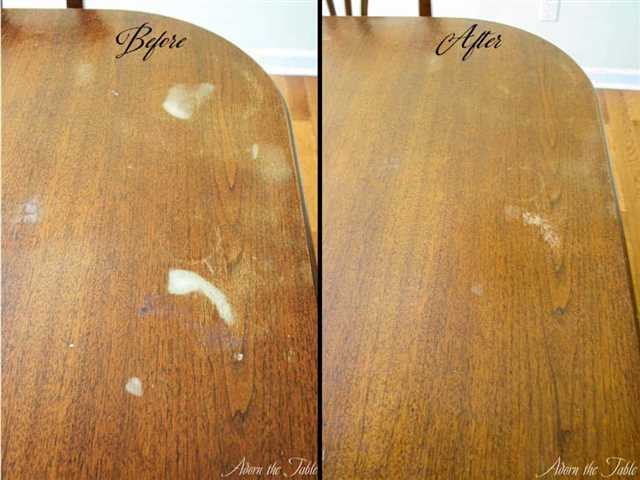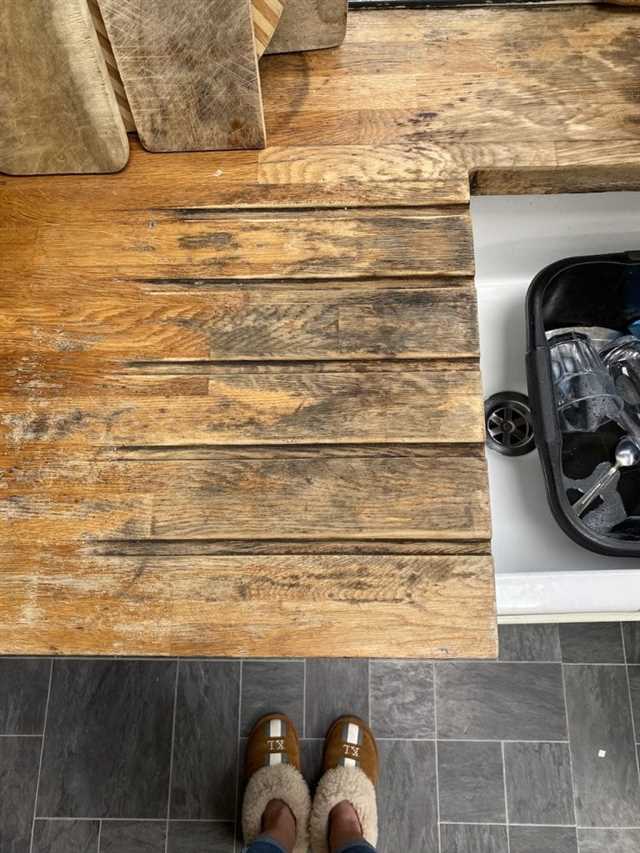
Wooden work surfaces in the kitchen can add a touch of elegance and warmth to any home. However, they are also prone to stains and discoloration due to their constant exposure to food stains and spills. To keep your worktops looking their best and maintain good hygiene, it is essential to know how to treat and eliminate these common issues.
Firstly, it’s important to regularly clean your wooden worktops to keep them free from dirt, bacteria, and food stains. Start by wiping down the worktops with a damp cloth to remove any loose dirt or debris. You can also use a mixture of vinegar and water (one tablespoon of vinegar per cup of water) to kill bacteria and disinfect the surface.
If you have a stain that is particularly stubborn, treating it with oils can be an effective solution. Danish oil or similar oils are recommended for this purpose. Apply a small amount of oil to the stained area and allow it to sit for a few minutes. Then, use a cloth to rub the oil into the wood, following the direction of the grain. This will help the oil penetrate the wood and lift the stain.
To avoid stains and discoloration in the first place, it’s important to take preventative measures. Use cutting boards and trivets to protect your worktops from hot pans and sharp knives. Clean up spills immediately and avoid leaving wet or moist items on the surface for too long. Regularly oiling your worktops can also make them more resistant to stains and spills.
In conclusion, maintaining the appearance of your wooden work surfaces requires regular cleaning and treating of stains. By following these simple steps, you can ensure that your worktops stay in top condition, making your kitchen a more hygienic and visually appealing space.
- Tips for Removing Stains and Discoloration on Wooden Work Surfaces
- 1. Sand and Refinish
- 2. Use a Stain Remover
- 3. Regular Cleaning and Maintenance
- 4. Avoid Excessive Heat and Moisture
- 5. Apply Protective Oils
- 6. Preventative Measures
- Effective Methods of Removing Stains
- 1. Identify the type of stain
- 2. Clean the stained area
- 3. Use natural remedies
- 4. Use specialized stains removers
- 5. Sand and refinish the surface
- 6. Prevent future stains
- FAQs
- Natural Solutions for Discoloration
- Oiling
- Vinegar Treatment
- Baking Soda Paste
- Avoiding Common Culprits
- Importance of Regular Cleaning and Maintenance
- Benefits of Regular Cleaning and Maintenance
- Steps to Clean and Maintain Wooden Work Surfaces
- Proper Sanding Techniques for Restoring Wood Surfaces
- Why Sanding is Important?
- Steps to Properly Sand Wood Surfaces
- Benefits of Regular Sanding
- Benefits of Regularly Oiling a Wood Worktop
- Video:
- Remove Water Stains from Wood for Good!
Tips for Removing Stains and Discoloration on Wooden Work Surfaces
Wooden work surfaces, such as countertops in the kitchen, often get stained or discolored over time due to various factors like burns, dirt, and food stains. However, there are several effective ways to eliminate these stains and restore the natural beauty of your wooden worktops. Here are some tips:
1. Sand and Refinish
If your wooden worktop has deep stains or discoloration, sanding down the surface may be necessary. Use sandpaper to gently remove the top layer of wood, working with the grain. This process helps to get rid of deep stains and reveal fresh wood underneath. After sanding, apply a suitable wood finish or treatment to protect and enhance the natural grain of the wood.
2. Use a Stain Remover
If the stains are not too severe, you can use a stain remover specifically designed for wooden surfaces. Apply the stain remover according to the instructions on the product, and gently rub the stained area with a cloth or sponge. This method can be effective for treating localized stains like crayon or wax marks that have been left on the worktop.
3. Regular Cleaning and Maintenance
To prevent stains and discoloration from occurring in the first place, it is essential to maintain regular cleaning and maintenance of your wooden worktop. Clean the surface thoroughly after each use with a mild cleaner or simply warm water and a cloth. Avoid using harsh chemicals or abrasive cleaners that can cause damage to the wood.
4. Avoid Excessive Heat and Moisture
Exposing your wooden worktop to excessive heat, such as placing hot pans directly on the surface, can lead to burns and discoloration. Additionally, prolonged exposure to moisture can cause the wood to warp or develop mold and bacteria. To avoid these issues, always use heat-resistant pads or trivets under hot pots and pans, and regularly dry your worktop to prevent moisture buildup.
5. Apply Protective Oils
To maintain the beauty and durability of your wooden worktop, apply food-safe oils regularly. These oils not only nourish the wood but also provide protection against stains and moisture. Commonly used oils include mineral oil, walnut oil, or Danish oil. Be sure to follow the manufacturer’s instructions for applying and maintaining the protective oil treatment.
6. Preventative Measures
To further prevent stains and discoloration on your wooden worktop, make sure to wipe up spills immediately, especially liquids like red wine or acidic substances. Use cutting boards or mats when working with sharp objects like knives to protect the surface from scratches. Regularly clean and sanitize your worktop, particularly in food preparation areas, to kill any bacteria and avoid food-related stains.
By following these tips and implementing a regular cleaning and maintenance routine, you can keep your wooden work surfaces looking vibrant and beautiful for years to come.
Effective Methods of Removing Stains
Stains on wooden work surfaces can be a common issue in kitchens. Luckily, there are several effective methods that can help you get rid of stains and restore the natural beauty of your worktop. Follow these steps to effectively remove stains:
1. Identify the type of stain
Firstly, it is important to identify the type of stain you are dealing with. Different stains require different treatment methods. Common types of stains include:
- Food stains
- Grease stains
- Ink stains
- Burnt marks
- Crayon marks
- Tar stains
2. Clean the stained area
Before applying any treatment, make sure to thoroughly clean the stained area. Use a mild cleanser and a damp cloth to wipe away any dirt or debris that may be covering the stain. This will help prepare the surface for treatment.
3. Use natural remedies

Many natural remedies can effectively eliminate stains from wooden worktops. Here are a few examples:
- Lemon juice: Squeeze fresh lemon juice onto the stained area and let it sit for a few minutes. Then, gently scrub the stain with a soft cloth.
- Vinegar: Mix one tablespoon of vinegar with one cup of water. Dip a cloth into the mixture and gently rub the stained area.
- Baking soda: Make a paste with baking soda and water, then apply it to the stain. Let it sit for a few minutes before gently scrubbing the area.
4. Use specialized stains removers

If natural remedies don’t work, there are specialized stain removers available on the market. Read the instructions carefully and follow them for best results. Choose a product that is compatible with wooden surfaces and recommended for use in kitchens.
5. Sand and refinish the surface
If the stain is deep and cannot be removed by cleaning or using natural remedies, sanding and refinishing may be necessary. This process involves removing the stained layer of wood and applying a new coat of finish to restore the surface.
6. Prevent future stains
Regular maintenance and proper care can help prevent stains from occurring in the first place. Here are some tips to protect your worktop:
- Wipe up spills immediately to avoid them penetrating the surface.
- Use cutting boards or mats to prevent knife marks and scratches.
- Avoid placing hot items directly on the worktop; use trivets or hot pads instead.
- Apply a food-safe oil or protective coating regularly to keep the surface sealed and protected.
- Clean the worktop regularly with a gentle cleanser to remove any dirt, grease, or bacteria.
FAQs
Q: Why are stains on wooden worktops hard to remove?
A: Wooden worktops are porous, which means they can absorb liquids and stains easily. Once a stain has penetrated the surface, it can be challenging to remove without proper treatment.
Q: How often should I apply the protective coating?
A: It is recommended to apply a food-safe oil or protective coating to your worktop every few months, or as needed. This will help maintain its overall appearance and protect it from stains and discoloration.
By following these effective methods and taking proper care of your wooden worktop, you can keep it looking clean and beautiful for years to come.
Natural Solutions for Discoloration
If you notice any discoloration on your wooden work surfaces, there are natural solutions you can try before resorting to harsh chemicals. These methods are safe for both you and the environment, and they can effectively remove stains and restore the beauty of your countertops.
Oiling
One natural solution to remove discoloration is by oiling the affected areas. Before applying oil, make sure to clean the worktops to remove any dirt or debris. You can use a vegetable oil, such as olive oil or coconut oil, to do this. Apply a generous amount of oil onto a clean cloth and rub it into the stained areas. Let it sit for a few hours or overnight, and then wipe off the excess oil. This process will help nourish the wood and remove any black stains.
Vinegar Treatment
Another natural solution is using vinegar to treat the discolored spots. Mix equal parts of vinegar and water in a spray bottle and spray it onto the affected areas. Let the solution sit for a few minutes, and then scrub the discolored spots using a soft cloth or sponge. Vinegar has natural cleaning properties that can help remove stains and restore the wood’s natural color.
Baking Soda Paste
Baking soda is known for its cleaning properties and can be used as a paste to remove stains from wooden surfaces. Mix one tablespoon of baking soda with enough water to create a paste. Apply the paste onto the discolored areas and gently scrub it using a cloth or sponge. Rinse the area with water and dry it thoroughly. This method is effective for removing ink, food stains, or even lipstick marks.
Avoiding Common Culprits
To maintain the beauty of your wooden worktops and prevent discoloration, it is important to avoid certain substances that can cause damage. Here are some common culprits:
- Avoid placing hot pots or pans directly onto the wooden surface, as it can cause burn marks.
- Avoid using harsh chemicals or abrasive cleaners that can strip away the finish and cause discoloration.
- Avoid leaving wet or damp items on the surface, as it can lead to water stains and mold growth.
- Avoid cutting or chopping directly on the worktop without using a cutting board, as it can leave deep scratches.
By treating and avoiding these common culprits, you can significantly reduce the likelihood of discoloration and keep your wooden worktops looking their best for years to come.
Importance of Regular Cleaning and Maintenance
Regular cleaning and maintenance of wooden work surfaces are essential for maintaining hygiene and preserving the quality of the wood. By regularly cleaning and maintaining your wooden work surfaces, you can prevent stains and discoloration, making them look clean, attractive, and as good as new.
Benefits of Regular Cleaning and Maintenance
- Prevention of Stains: Regular cleaning helps to remove food, burns, wax, Danish oil, paint, and other stains that may occur on the surface. By promptly removing spills and stains, you can avoid the formation of permanent marks on the wood.
- Hygiene: Cleaning the wooden work surfaces ensures that the area remains free from bacteria and other harmful microorganisms. This is especially important in the kitchen, where food is prepared.
- Restoring the Surface: Regular cleaning and maintenance help to restore the natural beauty of the wood. Sanding the surface and applying a fresh coat of oil or varnish can help to eliminate any scratches or dullness that may have occurred over time.
- Preventing Damage: Regular cleaning and maintenance can help to prevent damage to the wood caused by moisture, heat, and other external factors. By treating the wooden work surfaces with oil or varnish, you can provide them with a protective coating.
Steps to Clean and Maintain Wooden Work Surfaces
- Cleaning: Start by wiping down the surface with a damp cloth to remove any dust or debris. For tougher stains, you can use a mixture of vinegar and water or a mild soap solution. Avoid using abrasive cleaners or scrub brushes that can damage the wood.
- Drying: After cleaning, make sure to dry the surface thoroughly to prevent the wood from absorbing excess moisture.
- Treating: Depending on the type of wood and the desired finish, you can apply a suitable treatment such as oil, varnish, or wax. Follow the instructions provided with the product and apply evenly in the direction of the wood grain.
- Regular Maintenance: To maintain the cleanliness and appearance of the wooden work surfaces, clean spills and stains as soon as possible and avoid placing hot objects directly on the surface. Use cutting boards and trivets to protect the wood from scratches and burns.
By following these steps and incorporating regular cleaning and maintenance into your routine, you can enjoy beautiful and well-maintained wooden work surfaces for years to come.
Proper Sanding Techniques for Restoring Wood Surfaces
When it comes to restoring wood surfaces, proper sanding techniques can be crucial. Over time, wooden worktops can become stained, discolored, or have stubborn spots that need to be removed. Sanding is the first step in restoring the solid surface of the wood.
Why Sanding is Important?
Sanding is important because it helps to remove any imperfections on the surface of the wood. This includes stains, discoloration, grease, ink, or burnt areas. Sanding will also help to remove any protective coatings that may have been previously applied to the wood.
Steps to Properly Sand Wood Surfaces
- Start by cleaning the wood surface. Wipe it down with a damp cloth to remove any dust, dirt, or spills.
- Use sandpaper or a sanding block with a fine grit to lightly sand the surface. This will help to remove any rough spots or imperfections.
- If there are stubborn spots or deep stains that cannot be easily removed, you can try using a vinegar and water solution or a commercial wood cleaner to treat the area.
- Once the surface has been sanded and cleaned thoroughly, you can apply a wood oil or wax to protect and enhance the wood.
Benefits of Regular Sanding
Regular sanding of wooden work surfaces is needed to maintain their beauty and durability. Sanding helps to remove stains, discoloration, and other imperfections that can occur over time. It also allows for the application of a food-safe treatment to keep the wood protected from spills and daily use in the kitchen.
By following these proper sanding techniques, you can keep your wooden worktops looking their best and ensure their longevity in your home.
Benefits of Regularly Oiling a Wood Worktop
Regularly oiling a wood worktop is a simple yet effective way to maintain its beauty and durability. Similar to how our skin needs regular moisturizing, wood worktops also benefit from regular oiling to keep them looking their best. Here are the key benefits of this important maintenance step:
-
Enhances the natural beauty: Oiling your wood worktop brings out its natural color and grain, making it look more vibrant and attractive. The oil penetrates into the wood, giving it a warm glow and highlighting its unique features.
-
Protects against stains and discoloration: Oiling forms a protective layer on the surface of the wood, preventing stains and discoloration from seeping in. It acts as a barrier against spills, food stains, and other common kitchen mishaps, keeping your worktop looking clean and fresh.
-
Reduces the likelihood of cracks and splits: Wood worktops can be susceptible to drying out and developing cracks over time. Regular oiling helps to keep the wood moisturized, preventing it from becoming overly dry and brittle. This helps to minimize the risk of cracks and splits, prolonging the life of your worktop.
-
Makes cleaning easier: An oiled worktop is much easier to clean than a dry one. The protective layer of oil makes it more resistant to dirt, grease, and grime, allowing you to simply wipe away spills and messes with a damp cloth. It also prevents food from sticking to the surface, making both daily and deep cleaning a breeze.
-
FAQ: How often should I oil my wood worktop?
A: The frequency of oiling depends on the usage and exposure of your worktop. As a general guideline, a new worktop should be oiled immediately after installation and then again every three to six months. However, it’s always best to consult the manufacturer’s guidelines or the supplier for specific recommendations.
-
Keeps the wood hydrated: Wood is a natural material that can absorb and release moisture depending on the environment. By regularly oiling your worktop, you help to maintain its moisture content and prevent it from drying out. This is especially crucial in environments with fluctuating humidity levels, such as kitchens.
-
Kitchen maintenance: In a kitchen, worktops are exposed to various types of stains, spills, and heat on a daily basis. Oiling regularly helps to create a protective barrier against these elements and makes the worktop more resistant to damage. It also helps to prevent burns from hot pots and pans, as the oil acts as an insulating layer.
In order to oil your wood worktop properly, follow these steps:
-
Clean the worktop: Before applying the oil, make sure the worktop is clean and free of any dust or debris. Use a mild cleaner or a damp cloth to wipe away any dirt or stains. Allow the worktop to dry completely before proceeding.
-
Sand out any rough areas: If there are any rough or uneven patches on the worktop, lightly sand them using a fine-grit sandpaper. This will ensure a smooth and even application of the oil.
-
Apply the oil: Pour a small amount of wood oil onto a clean cloth or directly onto the worktop. Start applying the oil in a circular motion, working your way across the entire surface. Make sure to cover the edges and any visible areas.
-
Wipe off excess oil: After applying the oil, let it sit for about half an hour to allow it to penetrate the wood. Then, using a clean cloth, wipe off any excess oil that hasn’t been absorbed. Be thorough but gentle to ensure an even finish.
-
Let it dry: Allow the worktop to dry for at least 24 hours before using it again. This will give the oil enough time to fully cure and bond with the wood surface.
-
Repeat the process: Depending on the type and quality of the oil used, you may need to repeat the oiling process every few months or as needed. This will help to maintain the protective layer and keep your worktop looking its best.
By regularly oiling your wood worktop, you can enjoy its many benefits while ensuring its longevity. Take the time to properly maintain your worktop, and it will continue to be a beautiful and functional centerpiece in your kitchen for years to come.








